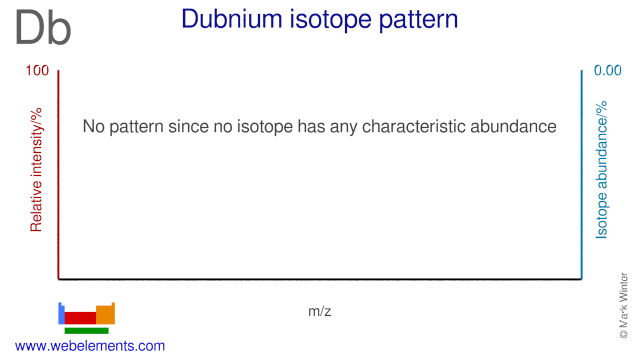Dubnium - 105Db: the essentials
- Name: dubnium
- Symbol: Db
- Atomic number: 105
- Relative atomic mass (Ar): [ 268.13 ] (longest lived isotope)
- Standard state: presumably a solid at 298 K
- Appearance: unknown, but probably metallic and silvery white or grey in appearance
- Classification: Metallic
- Group in periodic table: 5
- Group name: (none)
- Period in periodic table: 7
- Block in periodic table: d
- Shell structure: 2.8.18.32.32.11.2
- CAS Registry: 53850-35-4
Dubnium atoms have 105 electrons and the shell structure is 2.8.18.32.32.11.2. The ground state electronic configuration of neutral dubnium is [Rn].5f14.6d3.7s2 (a guess based upon that of tantalum) and the term symbol of dubnium is 4F3/2 (a guess based upon guessed electronic structure).
Dubnium: description
Dubnium is a synthetic element that is not present in the environment at all. It has no uses.
Dubnium: physical properties
Density of solid: 21600 (predicted) kg m-3
Molar volume: 12 (rough estimate based upon density estimate) cm3
Thermal conductivity: 58 (estimate) W m‑1 K‑1
Dubnium: heat properties
Melting point: (no data) K
Boiling point: (no data) K
Enthalpy of fusion: 20.5 kJ mol-1
Dubnium: atom sizes
Atomic radius (empirical): (no data) pm
Molecular single bond covalent radius: 149 (coordination number 5) ppm
van der Waals radius: (no data) ppm
Dubnium: electronegativities
Pauling electronegativity: (no data) (Pauling units)
Allred Rochow electronegativity: (no data) (Pauling units)
Mulliken-Jaffe electronegativity: (no data)
Dubnium: orbital properties
First ionisation energy: 656 (calculated) kJ mol‑1
Second ionisation energy: 1350 kJ mol‑1
Third ionisation energy: 2230 kJ mol‑1
Dubnium: abundances
Universe: (no data) ppb by weight
Crustal rocks: (no data) ppb by weight
Human: (no data) ppb by weight
Dubnium: crystal structure

Dubnium: biological data
Human abundance by weight: (no data) ppb by weight
Dubnium has no biological role.
Dubnium: uses
Dubnium: reactions
Reactions of dubnium as the element with air, water, halogens, acids, and bases where known.
Dubnium: binary compounds
Binary compounds with halogens (known as halides), oxygen (known as oxides), hydrogen (known as hydrides), and other compounds of dubnium where known.
Dubnium: compound properties
Bond strengths; lattice energies of dubnium halides, hydrides, oxides (where known); and reduction potentials where known.
Dubnium: history
Dubnium was discovered by Workers at the Nuclear Institute at Dubna, and the University of California, Berkeley, USA. in 1967 at USSR, United States. Origin of name: the origin of the name dubnium is the Joint Nuclear Institute at Dubna", an institute heavily involved in the search for heavy elements.Dubnium: isotopes

Dubnium: isolation
Isolation: only very small amounts of of element 105, dubnium, have ever been made. The first samples were made through nuclear reactions involving fusion of an isotope of californium, 249Cf, with one of nitrogen, 14N. A second route to the same isotope via berkelium is also known
15N + 249Cf → 261105Db + 4 1n
16N + 249Bk → 261105Db + 4 1n
Isolation of an observable quantity of dubnium has never been achieved.
